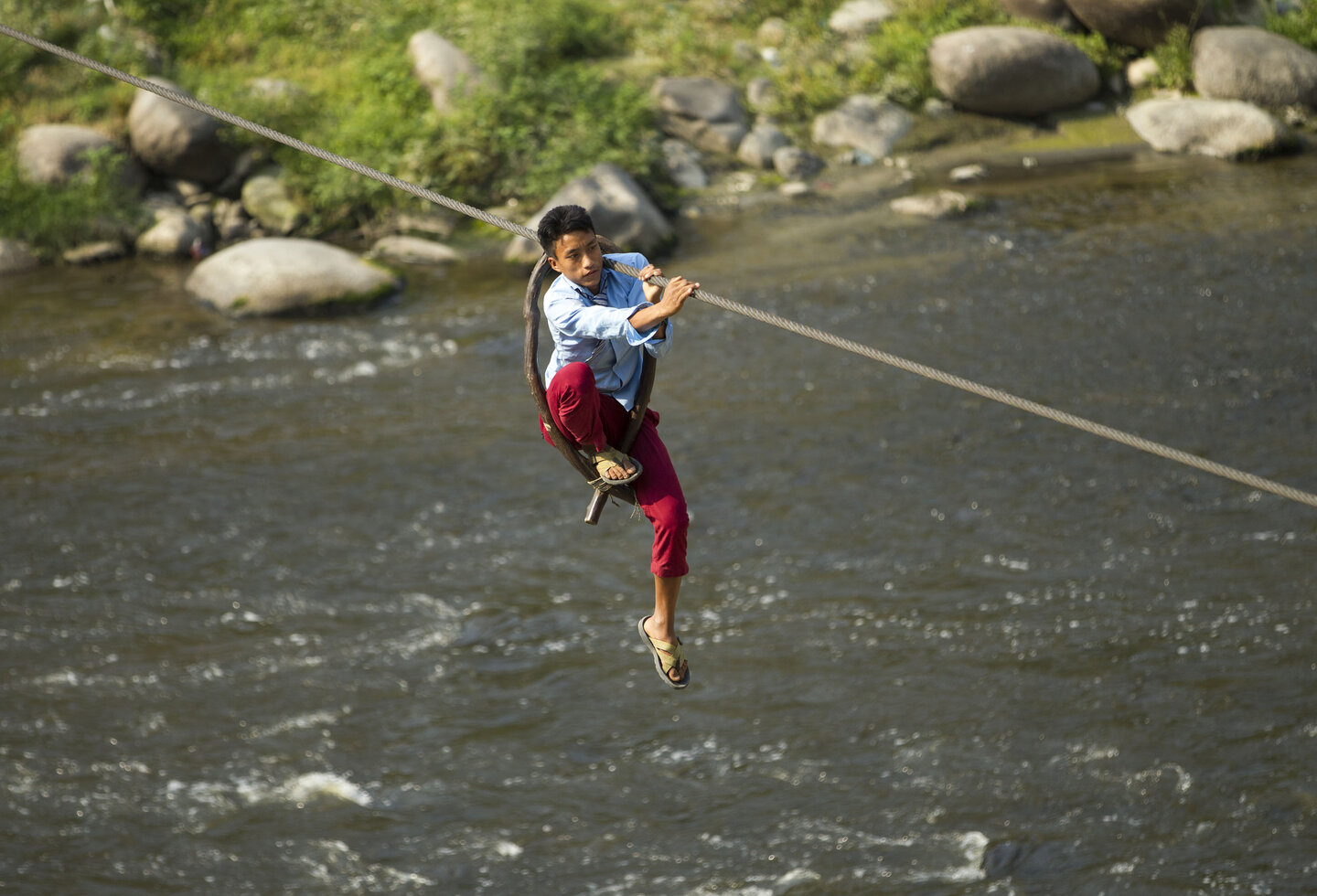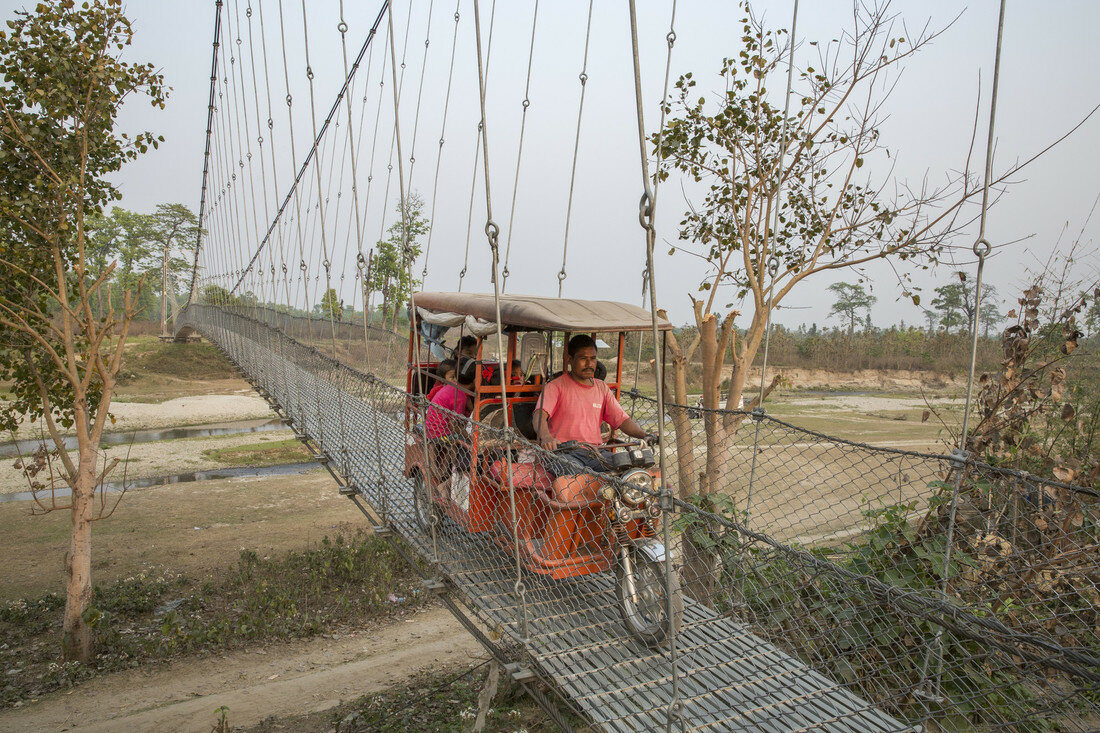The long-standing Swiss support to trail bridge building in Nepal, funded by the Swiss Agency for Development and Cooperation (SDC) and its mandated technical assistance provider, Helvetas, has left an indelible mark on the development of the sector and the lives of millions of people in Nepal. By connecting communities and fostering sustainable development, the bridges have become symbols of innovation and demonstrate the power of long-standing collaboration between the people of Nepal and Switzerland. This is a partnership that Helvetas is extending to other countries where similar challenges and needs persist, and where government, communities and the private sector can benefit from the learnings gained from the experiences in Nepal.
The success in localization of trail bridge building in Nepal
When SDC’s assistance first started in 1964, a systematic approach to bridge building began with the establishment of the Suspension Bridge Division (SBD) by the government of Nepal. This included support from the Swiss Association for Technical Assistance (SATA), whereby Swiss engineers supported the government to construct trail bridges and develop norms and standards.
From 1964 until the 1980s, less than 50 trail bridges were constructed annually. Each bridge had to be individually designed and departmental camps (fully staffed with a team of engineers, site-in-charge, and accounting staff) had to be established at the sites for months during the construction cycle. Bridge construction took up to three years in comparison to less than two years today.
Unsurprisingly, the outputs were not enough to meet the voluminous demands. Nepal’s rugged terrain, which features over 6,000 rivers and rivulets, has always made travel and transportation a challenge. The population was largely dependent on traversing these rivers through risky and rudimentary means such as wooden logs, bamboo bridges, boats or swimming. Lives were tragically lost, and, during the monsoons when rivers swell and trails become treacherous, the hardships get further exacerbated and sometimes isolate communities for months.

The biggest turning point in trail bridge building was the scaling-up of the Bridge Building at Local Level (BBLL) technology, which was funded by the SDC and developed and implemented by Helvetas in 1989 following successful piloting of the technology. By upgrading the local technology to optimize local skills and materials, while at the same time ensuring that engineering requirements were met, the designs became simpler and cost-effective. They were also able to be managed by local communities through organized Users’ Committees, with the support from local NGOs. This approach was termed the “Community Approach,” and was hugely successful in promoting local ownership, resulting in a dramatic increase in trail bridge outputs (which rose from an average of less than 50 to more than 150 bridges built annually by the 2000s).
Since then, with continuous technical assistance from Helvetas on behalf of the SDC, the trail bridge technology has been standardized and developed into 16 manuals (on technical, social mobilization and implementation modalities). These manuals have been formalized and form the backbone of trail bridge building in Nepal. They are used by bridge technicians and builders. They are referred to for teaching new students and technicians in the elective classes of engineering and technical institutions, respectively.
Over the years, the designs have undergone refinement, such as the replacement of the previous wooden walkway decks (which needed to be replaced regularly) with galvanized steel in the 1990s, leading to better longevity, and more recently after the earthquake in 2015 for further durability. New designs with pile foundations in the southern plains of the country have also been developed to account for low bearing capacities and to mitigate the erosive and meandering nature of rivers. Walkway decks have also been widened, as per the local demand, to allow motorcycles and three-wheelers to cross.

Switzerland has also been a driving force in involving local communities in decision-making processes through inclusive Users’ Committees for planning, management during construction and maintenance. These aspects were later institutionalized in the Nepal Trail Bridge Strategy in 2006. This strategy was a major milestone since it set a national target to ensure that no citizen has to take a detour of more than one hour to access public services. It also brought uniformity in terms of technology, standards, norms, specifications and implementation modalities to bridge building.
Later, with the introduction of the Sector Wide Approach in trail bridge building in 2009, Helvetas, on behalf of SDC, continued to provide technical assistance for the entire country alongside the government-led trail bridge program. Since then, the sector has seen a dramatic rise in the average annual outputs in each successive phase: 284 bridges (2009-2014), 460 bridges (2014-2019), and 593 bridges (2019-2023). A record 740 bridges were completed in 2023.
A main reason for these high outputs has been the development of skilled bridge builders (within the government, local NGOs and the private sector). Over 3,000 practitioners (engineers, sub-engineers and assistant sub-engineers) and over 6,000 bridge craftspersons and User’s Committees have been oriented and trained on trail bridge building since 2000.
In 2015, when the new constitution of Nepal was promulgated, Helvetas, on behalf of SDC, also supported the government to adjust the trail bridge program to the newly established local and provincial entities. Primarily, this included the need to strengthen the new local governments (called palikas), which hold the main responsibility for trail bridge construction (planning, budgeting, procurement, execution and maintenance); and provincial governments, which are responsible for the management of stores (of cables, steel wires and bulldog grips) and their distribution, technical backstopping for the local governments, monitoring systems, and construction of complex bridges. The federal government, meanwhile, was mandated by the federal steering committee of the trail bridge for policy formulation and construction of strategic and signature bridges and bridges on international borders.
Nepal built its 10,000th bridge in July 2023. This is a remarkable achievement, not only in terms of the construction of the bridges themselves, but especially when one considers that over 1 million people use the bridges every day. The bridges also act as catalysts for social and economic changes – by enhancing access to schools, health facilities and markets, and facilitating the exchange of ideas and people in previously isolated communities.
This milestone also demonstrates that the sector has come a long way. By introducing innovations, fostering local ownership, developing skills and transferring technical know-how, the sector has matured and is now led by Nepalese bridge builders and is delivering outputs and outcomes effectively and efficiently. This is why over the past four years Switzerland has steadily transferred its roles to relevant stakeholders.
Later in the year, Switzerland will conclude this longstanding and successful project with great satisfaction and pride. Meanwhile, the government is set to continue trail bridge building on its own. The SDC and Helvetas are proud to have been a part of this collaboration.
Transferring trail bridge know-how through South-South Collaboration
A new chapter has already begun with the establishment of the South-South Collaboration Unit (SSCU) within Helvetas Nepal. Established in 2009, the goal of this unit is to transfer trail bridge know-how and construction models to other countries with similar rural infrastructure needs and challenges.
By tailoring the technical expertise to the local context, Nepalese experts in the SSCU have been providing technical assistance for the design and on-site construction of over 150 trail bridges (in Bhutan, Tanzania, Mozambique, Indonesia, Ethiopia, Burundi, Laos and Vietnam) as well as supporting the establishment of trail bridge projects and developing the curriculum and training manual for trail bridge building (in Bhutan, Ethiopia, Honduras and Guatemala).
Currently, the SSCU is focused on Ethiopia to develop the capacities of relevant partners and stakeholders to establish an entire trail bridge program. The initial target is to construction 150 trail bridges across the country. However, the overarching goal is to develop and capacitate local engineers, technicians and communities so that they themselves implement the program, with the SSCU providing specialized expertise only when required.
About the Authors
Ansu Tumbahangfe is the Results Monitoring and Human Resource Manager at Helvetas’ Trail Bridge Support Unit. Gyanendra Rajbhandari is the Capacity Building and Mentoring Chief at Helvetas’ Trail Bridge Support Unit.


